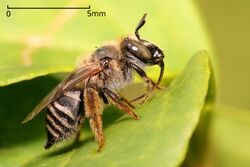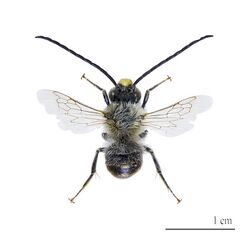Biology:Eucerini
| Eucerini | |
|---|---|

| |
| Female Tetraloniella sp. | |
| Scientific classification | |
| Domain: | Eukaryota |
| Kingdom: | Animalia |
| Phylum: | Arthropoda |
| Class: | Insecta |
| Order: | Hymenoptera |
| Family: | Apidae |
| Subfamily: | Apinae |
| Tribe: | Eucerini Latreille, 1802 |
| Genera | |
|
Over 30, see text | |
The Eucerini (often called longhorn bees or long-horned bees) are the most diverse tribe in the family Apidae, with over 32 genera worldwide that were previously classified as members of the family Anthophoridae. All species are solitary, though many nest in large aggregations, and large "sleeping" aggregations of males are found occasionally. Most genera are distinctive in the unusually long male antennae from which the tribe derives its name (eucer- means true horned). They are most diverse in the Western Hemisphere.
Classification
The classification within the tribe is rather chaotic, as many of the genera are small and poorly characterized, with the bulk of species (about 500) in only five genera. This is a group in serious need of a thorough taxonomic overhaul, and the fusion of many genera would likely result (a revision in 2000 eliminated seven genera and another in 2018 eliminated six more).[1]
Genera
- Agapanthinus LaBerge, 1957
- Alloscirtetica Holmberg, 1909
- Canephorula Jörgensen, 1909
- Cemolobus Robertson, 1902 (recently moved into Eucera)
- Cubitalia Friese, 1911
- Eucera Scopoli, 1770
- Eucerinoda Michener & Moure, 1957
- Florilegus Robertson, 1900
- Gaesischia Michener, LaBerge & Moure, 1955
- Gaesochira Moure & Michener, 1955
- Hamatothrix Urban, 1989
- Lophothygater Moure & Michener, 1955
- Martinapis Cockerell, 1929
- Melissodes Latreille, 1829
- Melissoptila Holmberg, 1884
- Micronychapis Moure & Michener, 1955
- Mirnapis
- Notolonia Popov, 1962
- Pachysvastra Moure & Michener, 1955
- Peponapis Robertson, 1902 (recently moved into Eucera)
- Platysvastra Moure, 1967
- Santiago Urban, 1989
- Simanthedon Zavortink, 1975
- Svastra Holmberg, 1884
- Svastrides Michener, LaBerge & Moure, 1955
- Svastrina Moure & Michener, 1955
- Syntrichalonia LaBerge, 1957 (recently moved into Eucera)
- Tetralonia Spinola, 1839 (recently moved into Eucera)
- Tetraloniella Ashmead, 1899
- Thygater Holmberg, 1884
- Trichocerapis Cockerell, 1904
- Ulugombakia
- Xenoglossa Smith, 1854 (recently moved into Eucera)
References
- ↑ Dorchin, A.; López-Uribe, M.M.; Praz, C.J.; Griswold, T.; Danforth, B.N. (2018). "Phylogeny, new generic-level classification, and historical biogeography of the Eucera complex (Hymenoptera: Apidae)". Molecular Phylogenetics and Evolution 119: 81–92. doi:10.1016/j.ympev.2017.10.007. ISSN 1055-7903. PMID 29122650.
- C. D. Michener (2000) The Bees of the World, Johns Hopkins University Press.
Wikidata ☰ Q3059472 entry
 |



